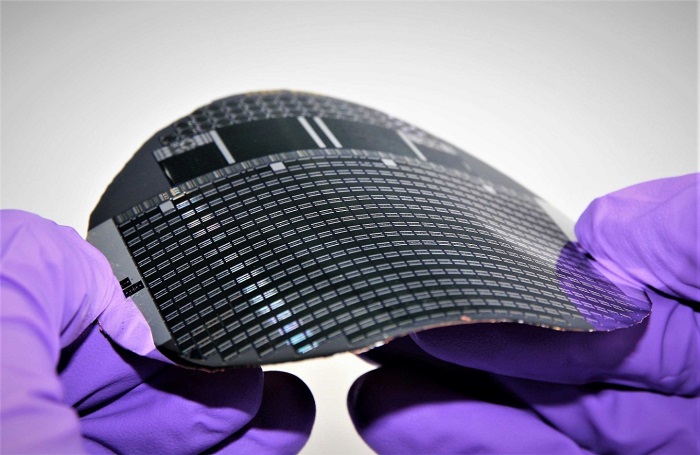Researchers at Fraunhofer Institute for Solar Energy Systems ISE have achieved a conversion efficiency of 68.9% for a III-V semiconductor photovoltaic cell based on gallium arsenide (GaAs) exposed to laser light of 858 nm. The mark is reportedly the highest efficiency yet achieved for the conversion of light into electricity.
The team used a thin-film technology in which the solar cell layers are first grown on a GaAs substrate, which is then removed. A conductive, highly reflective mirror is applied to the back surface of the remaining semiconductor structure, which is only a few micrometers thick.
In photovoltaic cells, light is absorbed in a cell structure, made of GaAs semiconductor material, for example. The absorbed light sets positive and negative charges free, which are in turn conducted to the front and back cell contacts, generating electricity. This “photovoltaic effect” is particularly efficient when the energy of the incident light lies slightly above the so-called bandgap energy that is inherent to the semiconductor material.
Therefore, very high efficiencies are theoretically possible when a monochromatic laser light source is matched with a suitable semiconductor compound material.
In this new form of energy transfer, called power by light, laser energy is delivered through the air or via an optical fiber to a photovoltaic cell, the properties of which match the power and the wavelength of the monochromatic laser light. Compared to conventional power transmission that uses copper wires, power by light systems are especially beneficial for applications that require a galvanically isolated power supply, lightning or explosion protection, electromagnetic compatibility, or completely wireless power transmission, for example.

The Fraunhofer ISE research team achieved a conversion efficiency of 68.9% under monochromatic laser light with a new thin-film photovoltaic cell based on gallium arsenide. The Fraunhofer teams said the efficiency is a record for the conversion of light into electricity. Courtesy of Henning Helmers/Fraunhofer ISE.
Henning Helmers, head of the Fraunhofer ISE research team, said that the leveraged thin-film approach has two distinct advantages for efficiency. “First of all, photons are trapped in the cell and the absorption is maximized for photon energies close to the bandgap, which simultaneously minimizes thermalization and transmission losses, making the cell more efficient," Helmers said.
"Secondly, the photons additionally generated internally by radiative recombination become trapped and effectively recycled. This extends the effective carrier lifetime, thus additionally increasing the voltage.”
The group investigated thin-film photovoltaic cells with back-surface reflectors made of gold and an optically optimized combination of ceramic and silver, with the latter showing the best results. An n-GaAs/p-AIGaAs heterostructure was developed as an absorber, which shows particularly low charge carrier losses due to recombination.
“This is an impressive result that shows the potential of photovoltaics for industrial applications beyond solar power generation,” said Andreas Bett, institute director of Fraunhofer ISE.
Applications for the technology include the structural monitoring of wind turbines, the monitoring of high-voltage lines, fuel sensors in aircraft tanks, passive optical networks, the optical supply of implants from outside the body, or a wireless power supply for applications in the Internet of Things.
The work was presented at the 48th IEEE Photovoltaic Specialists Conference (www.doi.org/10.1002/pssr.202100113).